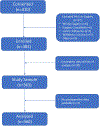Patient and Procedural Determinants of Postoperative Pain Trajectories
- PMID: 33449996
- PMCID: PMC8726009
- DOI: 10.1097/ALN.0000000000003681
Patient and Procedural Determinants of Postoperative Pain Trajectories
Abstract
Background: The primary goal of this study was to evaluate patterns in acute postoperative pain in a mixed surgical patient cohort with the hypothesis that there would be heterogeneity in these patterns.
Methods: This study included 360 patients from a mixed surgical cohort whose pain was measured across postoperative days 1 through 7. Pain was characterized using the Brief Pain Inventory. Primary analysis used group-based trajectory modeling to estimate trajectories/patterns of postoperative pain. Secondary analysis examined associations between sociodemographic, clinical, and behavioral patient factors and pain trajectories.
Results: Five distinct postoperative pain trajectories were identified. Many patients (167 of 360, 46%) were in the moderate-to-high pain group, followed by the moderate-to-low (88 of 360, 24%), high (58 of 360, 17%), low (25 of 360, 7%), and decreasing (21 of 360, 6%) pain groups. Lower age (odds ratio, 0.94; 95% CI, 0.91 to 0.99), female sex (odds ratio, 6.5; 95% CI, 1.49 to 15.6), higher anxiety (odds ratio, 1.08; 95% CI, 1.01 to 1.14), and more pain behaviors (odds ratio, 1.10; 95% CI, 1.02 to 1.18) were related to increased likelihood of being in the high pain trajectory in multivariable analysis. Preoperative and intraoperative opioids were not associated with postoperative pain trajectories. Pain trajectory group was, however, associated with postoperative opioid use (P < 0.001), with the high pain group (249.5 oral morphine milligram equivalents) requiring four times more opioids than the low pain group (60.0 oral morphine milligram equivalents).
Conclusions: There are multiple distinct acute postoperative pain intensity trajectories, with 63% of patients reporting stable and sustained high or moderate-to-high pain over the first 7 days after surgery. These postoperative pain trajectories were predominantly defined by patient factors and not surgical factors.
Copyright © 2021, the American Society of Anesthesiologists, Inc. All Rights Reserved.
Figures






Comment in
-
Personalization over Protocolization.Anesthesiology. 2021 Mar 1;134(3):363-365. doi: 10.1097/ALN.0000000000003695. Anesthesiology. 2021. PMID: 33465232 Free PMC article. No abstract available.
-
Acute Postoperative Pain Trajectory Groups: Comment.Anesthesiology. 2021 Sep 1;135(3):547. doi: 10.1097/ALN.0000000000003875. Anesthesiology. 2021. PMID: 34270688 No abstract available.
-
Acute Postoperative Pain Trajectory Groups: Reply.Anesthesiology. 2021 Sep 1;135(3):547-548. doi: 10.1097/ALN.0000000000003874. Anesthesiology. 2021. PMID: 34270702 Free PMC article. No abstract available.
References
-
- Gan TJ, Habib AS, Miller TE, White W, Apfelbaum JL: Incidence, patient satisfaction, and perceptions of post-surgical pain: results from a US national survey. Curr Med Res Opin 2014; 30: 149–60 - PubMed
-
- Gilron I, Vandenkerkhof E, Katz J, Kehlet H, Carley M: Evaluating the association between acute and chronic pain after surgery: impact of pain measurement methods. Clin J Pain 2017; 33: 588–94 - PubMed
-
- Richebe P, Capdevila X, Rivat C: Persistent postsurgical pain: pathophysiology and preventative pharmacologic considerations. Anesthesiology 2018; 129: 590–607 - PubMed
-
- Treede RD, Rief W, Barke A, Aziz Q, Bennett MI, Benoliel R, Cohen M, Evers S, Finnerup NB, First MB, Giamberardino MA, Kaasa S, Kosek E, Lavand’homme P, Nicholas M, Perrot S, Scholz J, Schug S, Smith BH, Svensson P, Vlaeyen JW, Wang SJ: A classification of chronic pain for ICD-11. Pain 2015; 156: 1003–7 - PMC - PubMed
-
- Macrae WA: Chronic post-surgical pain: 10 years on. Br J Anaesth 2008; 101: 77–86 - PubMed
Publication types
MeSH terms
Substances
Grants and funding
LinkOut - more resources
Full Text Sources
Other Literature Sources

